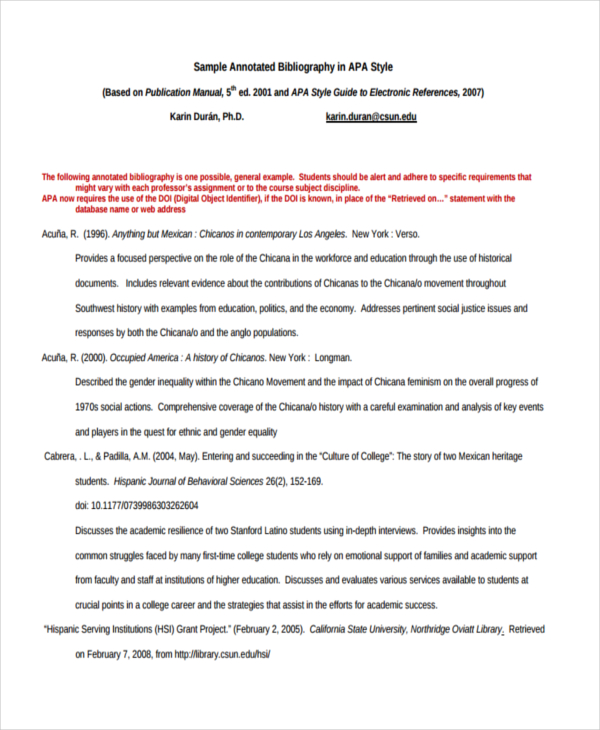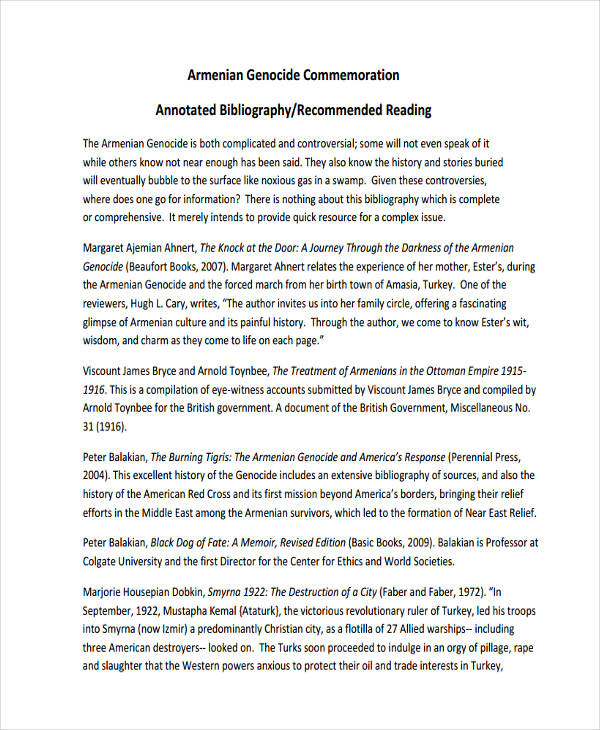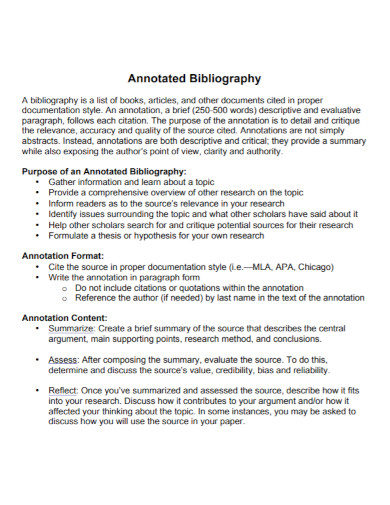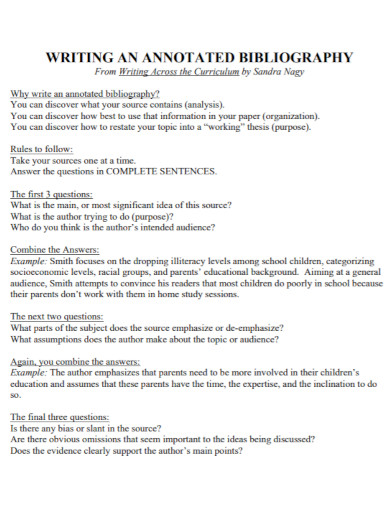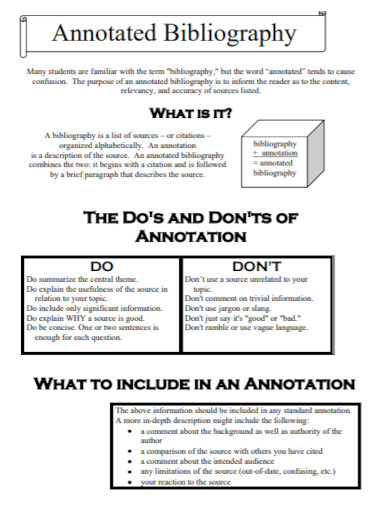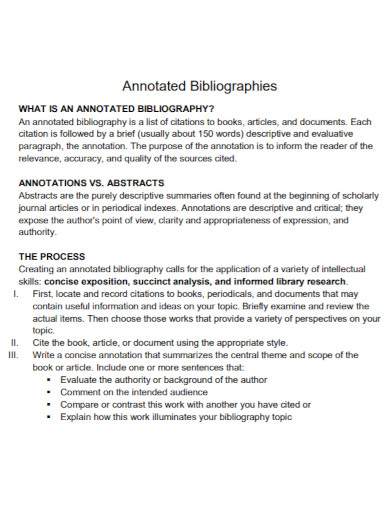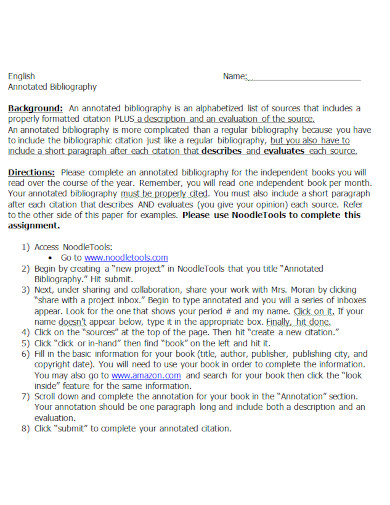20+ Annotated Bibliography Examples
You may have gone through this once in your life or even daily, depending on the work you do. But looking for sources to support the research you are doing for a topic is also necessary. Bibliographies come in different forms, they could be enumerative, analytical, or even annotated.
What Is an Annotated Bibliography?
An annotated bibliography is simply a list of sources, such as book, articles, and documents, that typically comes with a brief description of each item. This could be to describe, gives an evaluation, or explain a given item. An annotated bibliography can be selective or comprehensive in nature.
Annotated Bibliography Format
An annotated bibliography is a list of citations to books, articles, and documents. Each citation is followed by a brief (usually about 150 words) descriptive and evaluative paragraph, the annotation. The purpose of the annotation is to inform the reader of the relevance, accuracy, and quality of the sources cited.
1. Title
The title should be concise and descriptive. For example, “Annotated Bibliography on Climate Change.”
2. Citations
Citations should be formatted according to the style guide you are following (APA, MLA, Chicago, etc.). Below are examples for APA and MLA styles.
APA Style
Format: Author(s). (Year). Title of the book. Publisher.
Example: Smith, J. (2020). Understanding Climate Change. Green Earth Publishers.
MLA Style
Format: Author(s). Title of the Book. Publisher, Year.
Example: Smith, John. Understanding Climate Change. Green Earth Publishers, 2020.
3. Annotations
Annotations should provide a summary of the source and evaluate its relevance, accuracy, and quality. Below are examples of annotations in APA and MLA styles.
APA Style
Format: Author(s). (Year). Title of the book. Publisher. Summary: A brief summary of the source’s content. Evaluation: An assessment of the source’s reliability and relevance. Reflection: How the source fits into your research.
Example: Smith, J. (2020). Understanding Climate Change. Green Earth Publishers. Summary: This book provides an overview of climate change, including its causes, effects, and potential solutions. Evaluation: The author is a renowned environmental scientist with numerous publications on the topic, making this a reliable source. Reflection: This source will be useful for understanding the basic concepts of climate change and its global impact.
MLA Style
Format: Author(s). Title of the Book. Publisher, Year. Summary: A brief summary of the source’s content. Evaluation: An assessment of the source’s reliability and relevance. Reflection: How the source fits into your research.
Example: Smith, John. Understanding Climate Change. Green Earth Publishers, 2020. Summary: This book provides an overview of climate change, including its causes, effects, and potential solutions. Evaluation: The author is a renowned environmental scientist with numerous publications on the topic, making this a reliable source. Reflection: This source will be useful for understanding the basic concepts of climate change and its global impact.
Types of Annotated Bibliography
Annotated bibliographies can serve various purposes depending on the needs of the researcher or the requirements of the assignment. They can be categorized based on the content of the annotations. Here are the main types:
1. Descriptive or Informative Annotated Bibliography
A descriptive or informative annotated bibliography provides a summary of the source. It describes the main points and arguments of the work without offering an evaluation.
Purpose: The purpose of a descriptive annotation is to inform the reader about the content of the source. It focuses on the main ideas and key points.
Example
Smith, J. (2020). Understanding Climate Change. Green Earth Publishers. Summary: This book provides an overview of climate change, including its causes, effects, and potential solutions. The author discusses various scientific studies and offers predictions for future climate patterns.
2. Evaluative or Critical Annotated Bibliography
An evaluative or critical annotated bibliography not only summarizes the source but also evaluates its quality, accuracy, and relevance. It provides a critical assessment of the source’s strengths and weaknesses.
Purpose: The purpose of an evaluative annotation is to provide an analysis of the source’s credibility and its contribution to the topic. It helps the reader understand the source’s value in relation to other research.
Example
Doe, A. (2019). Climate Change: A Comprehensive Study. Blue Ocean Press. Summary: This study examines the impact of climate change on various ecosystems. Evaluation: The research is thorough and well-documented, making it a credible source. However, the author’s strong bias towards policy advocacy might influence the interpretation of the data.
3. Summative Annotated Bibliography
A summative annotated bibliography combines elements of both descriptive and evaluative annotations. It provides a summary of the source along with a brief evaluation.
Purpose: The purpose of a summative annotation is to give a comprehensive overview of the source, covering both its content and its usefulness.
Example
Brown, C. (2018). The Economics of Climate Change. Eco Press. Summary: This book explores the economic impacts of climate change, discussing both the costs and potential benefits. Evaluation: The author’s analysis is balanced and well-supported by empirical data, making it a valuable resource for understanding the economic implications of environmental policies.
4. Indicative Annotated Bibliography
An indicative annotated bibliography provides a general overview of the source. It outlines the main topics or themes covered without delving into specific details or evaluations.
Purpose: The purpose of an indicative annotation is to give the reader an idea of what the source covers, allowing them to decide if it is relevant to their research.
Example
Williams, L. (2017). Environmental Policy and Climate Change. Green Leaf Publications. Summary: This book discusses various environmental policies related to climate change, including international agreements and national regulations.
Annotated bibliography Examples for Students
1. Book
Citation: Smith, J. (2020). The Art of Effective Study. Academic Press.
Annotation: This book provides comprehensive strategies for effective study habits, including time management, note-taking, and test preparation. Smith emphasizes the importance of discipline and organization in achieving academic success. The book is well-researched and includes practical examples, making it a valuable resource for students.
Evaluation: The book is thorough and covers a wide range of topics related to study techniques. Smith’s writing is clear and accessible, and the strategies provided are backed by research. However, some sections could benefit from more detailed explanations.
Reflection: This source will be useful in the section of my project discussing effective study techniques. It provides practical advice that can be directly applied to improve academic performance.
2. Journal Article
Citation: Johnson, L. & Lee, M. (2021). The impact of social media on student productivity. Journal of Educational Psychology, 33(4), 456-469. https://doi.org/10.1234/jep.2021.0456
Annotation: Johnson and Lee explore the effects of social media on students’ productivity through a series of controlled experiments. The study finds a significant negative correlation between social media usage and academic performance. The article is peer-reviewed and provides strong empirical evidence.
Evaluation: The study is well-designed and offers valuable insights into the impact of social media on student productivity. The findings are significant and supported by robust data analysis. However, the sample size is relatively small, which may limit the generalizability of the results.
Reflection: This source will help illustrate the negative aspects of social media in my research on student productivity. Its empirical evidence will support my argument on the detrimental effects of excessive social media use.
3. Website
Citation: National Institute of Mental Health. (2022, January 15). Tips for managing stress. NIMH. https://www.nimh.nih.gov/tips-for-managing-stress
Annotation: This webpage offers practical tips for managing stress, including relaxation techniques and lifestyle changes. The information is reliable and up-to-date, making it a valuable resource for those seeking to improve their mental health.
Evaluation: The tips provided are practical and easy to implement. The website is credible, being an official health institute, and the information is presented in a clear and concise manner. However, it lacks in-depth explanations of some techniques.
Reflection: This source will be used to provide stress management strategies in my project on student well-being. Its practical advice will help support the section on coping mechanisms for academic stress.
4. Book Chapter
Citation: Brown, R. (2019). Cognitive development in early childhood. In S. Green & P. White (Eds.), Foundations of Child Psychology (pp. 45-68). Springer.
Annotation: Brown discusses the stages of cognitive development in early childhood, providing insights from various psychological theories. The chapter is thorough and includes references to key studies in the field.
Evaluation: The analysis is well-structured and accessible, making it a valuable resource for understanding early cognitive development. Brown effectively integrates different theoretical perspectives. However, the chapter could benefit from more recent studies.
Reflection: This source will be used to support the theoretical framework of my research on child psychology. It provides a foundation for discussing developmental stages and will help contextualize my findings.
5. Magazine Article
Citation: Martinez, L. (2023, June 10). The future of educational technology. Education Today, 45(6), 22-25.
Annotation: Martinez explores emerging trends in educational technology, including AI and virtual reality. The article is well-researched and provides insights into the potential future of education.
Evaluation: The article is informative and offers a comprehensive overview of potential technological advancements in education. However, it lacks empirical data to support some of its claims. Despite this, it is a valuable resource for understanding future trends.
Reflection: This source will be used to discuss technological advancements in my project on education. It will provide a contemporary perspective on how technology can enhance learning experiences.
Annotated Bibliography Examples for College Students
1. Scholarly Book
Citation: Smith, J. (2020). The Art of Effective Study. Academic Press.
Annotation: Smith provides comprehensive strategies for effective study habits, including time management, note-taking, and test preparation. Emphasizing the importance of discipline and organization, the book is well-researched and includes practical examples.
Evaluation: The book is thorough and covers a wide range of topics related to study techniques. Smith’s writing is clear and accessible, making the strategies easy to understand and implement. However, more detailed explanations in some sections would enhance its usefulness.
Reflection: This source will be particularly useful for the section of my project that discusses effective study techniques. It offers practical advice that I can apply directly to improve my academic performance.
2. Journal Article
Citation: Johnson, L. & Lee, M. (2021). The impact of social media on student productivity. Journal of Educational Psychology, 33(4), 456-469. https://doi.org/10.1234/jep.2021.0456
Annotation: Johnson and Lee explore the effects of social media on students’ productivity through controlled experiments. The study finds a significant negative correlation between social media usage and academic performance.
Evaluation: The study is well-designed and offers valuable insights into the impact of social media on student productivity. The findings are significant and supported by robust data analysis, though the relatively small sample size may limit the generalizability of the results.
Reflection: This source will help illustrate the negative aspects of social media in my research on student productivity, providing empirical evidence to support my argument on the detrimental effects of excessive social media use.
3. Government Website
Citation: National Institute of Mental Health. (2022, January 15). Tips for managing stress. NIMH. https://www.nimh.nih.gov/tips-for-managing-stress
Annotation: This webpage from the National Institute of Mental Health offers practical tips for managing stress, including relaxation techniques and lifestyle changes.
Evaluation: The tips are practical and easy to implement. The website is credible and the information is presented in a clear and concise manner. However, it lacks in-depth explanations of some techniques.
Reflection: This source will be used to provide stress management strategies in my project on student well-being, offering practical advice for coping with academic stress.
4. Book Chapter
Citation: Brown, R. (2019). Cognitive development in early childhood. In S. Green & P. White (Eds.), Foundations of Child Psychology (pp. 45-68). Springer.
Annotation: Brown discusses the stages of cognitive development in early childhood, providing insights from various psychological theories. The chapter includes references to key studies in the field.
Evaluation: The chapter is well-structured and accessible, making it a valuable resource for understanding early cognitive development. Brown effectively integrates different theoretical perspectives, though more recent studies would enhance the chapter.
Reflection: This source will support the theoretical framework of my research on child psychology, providing a foundation for discussing developmental stages and contextualizing my findings.
5. Magazine Article
Citation: Martinez, L. (2023, June 10). The future of educational technology. Education Today, 45(6), 22-25.
Annotation: Martinez explores emerging trends in educational technology, including AI and virtual reality. The article provides insights into the potential future of education.
Evaluation: The article is informative and offers a comprehensive overview of potential technological advancements in education. However, it lacks empirical data to support some of its claims. Despite this, it is a valuable resource for understanding future trends.
Reflection: This source will be used to discuss technological advancements in my project on education, providing a contemporary perspective on how technology can enhance learning experiences.
Examples of Annotated Bibliography in APA Format
1. Research Report
Citation: Pew Research Center. (2023). The state of online learning: A comprehensive study. Pew Research Center. https://www.pewresearch.org/online-learning
Annotation: The report provides an in-depth analysis of the current trends in online learning, including demographic data, student performance metrics, and user satisfaction. The study highlights the rapid growth of online education and its impact on traditional learning environments.
Evaluation: This report is highly detailed and utilizes a wide range of data sources, making it a credible and comprehensive resource. However, it is primarily descriptive and lacks a critical analysis of the data presented.
Reflection: This source will be instrumental in providing current data and trends in the online education section of my project, offering a broad overview of the state of online learning today.
2. Documentary Film
Citation: Morris, T. (Director). (2020). The digital classroom: Technology in education [Film]. Educational Media Productions.
Annotation: The documentary explores the integration of technology in modern classrooms, featuring interviews with educators, students, and technology experts. It examines both the benefits and challenges of digital tools in education.
Evaluation: The film is well-produced and offers diverse perspectives on the subject. The visual and anecdotal evidence provided is compelling, though it could benefit from more empirical data to support its claims.
Reflection: This documentary will be useful in illustrating real-world applications and challenges of educational technology, complementing the more data-driven sources in my research.
3. Encyclopedia Entry
Citation: Encyclopedia Britannica. (2021). Mindfulness. In Encyclopedia Britannica online. https://www.britannica.com/topic/mindfulness
Annotation: The entry provides a concise overview of mindfulness, its origins, and its applications in various fields such as psychology, education, and healthcare. It also includes references to key studies and practitioners in the field.
Evaluation: As a tertiary source, the entry is a reliable and accessible summary of the topic. However, it lacks the depth and detailed analysis found in primary and secondary sources.
Reflection: This entry will serve as a foundational overview of mindfulness, helping to frame the broader context for the more detailed studies and articles I will use in my project.
4. Blog Post
Citation: Walker, K. (2022, September 14). How to balance work and study: Tips from successful students. College Life Blog. https://www.collegelifeblog.com/balance-work-study
Annotation: Walker shares practical advice from successful students on how to balance work and study commitments. The post includes time management strategies, personal anecdotes, and links to additional resources.
Evaluation: The blog post is engaging and practical, written in an accessible style that resonates with its target audience. However, it is anecdotal and lacks the empirical support found in academic sources.
Reflection: This source will provide practical tips and real-life examples for the section of my project on time management, offering a relatable perspective to complement academic research.
5. Newspaper Article
Citation: Green, A. (2023, March 5). Schools adopt new technologies to enhance learning. The New York Times. https://www.nytimes.com/2023/03/05/education/schools-new-technologies.html
Annotation: Green discusses the latest technological innovations being adopted by schools to enhance learning, including virtual reality, AI, and personalized learning platforms. The article includes interviews with educators and students.
Evaluation: The article is current and provides firsthand accounts of the impact of new technologies in education. However, it is relatively short and lacks the depth of academic journal articles.
Reflection: This source will be valuable for providing contemporary examples of technological advancements in education, helping to illustrate the practical applications of the concepts discussed in my research.
Examples of Annotated Bibliography in MLA Format
1. Book
Citation: Smith, John. The Art of Effective Study. Academic Press, 2020.
Annotation: Smith provides comprehensive strategies for effective study habits, including time management, note-taking, and test preparation. Emphasizing the importance of discipline and organization, the book is well-researched and includes practical examples.
Evaluation: The book is thorough and covers a wide range of topics related to study techniques. Smith’s writing is clear and accessible, making the strategies easy to understand and implement. However, more detailed explanations in some sections would enhance its usefulness.
Reflection: This source will be particularly useful for the section of my project that discusses effective study techniques. It offers practical advice that I can apply directly to improve my academic performance.
2. Journal Article
Citation: Johnson, Linda, and Mark Lee. “The Impact of Social Media on Student Productivity.” Journal of Educational Psychology, vol. 33, no. 4, 2021, pp. 456-469.
Annotation: Johnson and Lee explore the effects of social media on students’ productivity through controlled experiments. The study finds a significant negative correlation between social media usage and academic performance.
Evaluation: The study is well-designed and offers valuable insights into the impact of social media on student productivity. The findings are significant and supported by robust data analysis, though the relatively small sample size may limit the generalizability of the results.
Reflection: This source will help illustrate the negative aspects of social media in my research on student productivity, providing empirical evidence to support my argument on the detrimental effects of excessive social media use.
3. Website
Citation: National Institute of Mental Health. “Tips for Managing Stress.” NIMH, 15 Jan. 2022, www.nimh.nih.gov/tips-for-managing-stress.
Annotation: This webpage from the National Institute of Mental Health offers practical tips for managing stress, including relaxation techniques and lifestyle changes.
Evaluation: The tips are practical and easy to implement. The website is credible and the information is presented in a clear and concise manner. However, it lacks in-depth explanations of some techniques.
Reflection: This source will be used to provide stress management strategies in my project on student well-being, offering practical advice for coping with academic stress.
4. Book Chapter
Citation: Brown, Rebecca. “Cognitive Development in Early Childhood.” Foundations of Child Psychology, edited by Susan Green and Peter White, Springer, 2019, pp. 45-68.
Annotation: Brown discusses the stages of cognitive development in early childhood, providing insights from various psychological theories. The chapter includes references to key studies in the field.
Evaluation: The chapter is well-structured and accessible, making it a valuable resource for understanding early cognitive development. Brown effectively integrates different theoretical perspectives, though more recent studies would enhance the chapter.
Reflection: This source will support the theoretical framework of my research on child psychology, providing a foundation for discussing developmental stages and contextualizing my findings.
5. Magazine Article
Citation: Martinez, Laura. “The Future of Educational Technology.” Education Today, vol. 45, no. 6, 10 June 2023, pp. 22-25.
Annotation: Martinez explores emerging trends in educational technology, including AI and virtual reality. The article provides insights into the potential future of education.
Evaluation: The article is informative and offers a comprehensive overview of potential technological advancements in education. However, it lacks empirical data to support some of its claims. Despite this, it is a valuable resource for understanding future trends.
Reflection: This source will be used to discuss technological advancements in my project on education, providing a contemporary perspective on how technology can enhance learning experiences.
More Annotated Bibliography Examples & Samples in PDF
1. Free Annotated Bibliography Example
2. Simple Annotated Bibliography
3. MLA Annotated Bibliography
4. APA Annotated Bibliography
5. Visual Annotated Bibliography
6. Annotated Bibliography Format in PDF
7. Annotated Bibliography Examples
8. Annotated Bibliography Document
9. Short Annotated Bibliography Examples
10. English Annotated Bibliography
Purpose of an Annotated Bibliography
An annotated bibliography serves several important purposes in academic research and writing. Below are the key purposes it fulfills:
1. Provide a Summary of Sources
An annotated bibliography summarizes the main ideas and arguments of each source. This helps the reader understand the content and scope of the sources without having to read them in full.
Example:
Smith, J. (2021). The Future of Renewable Energy. Green Energy Publishers. Summary: This book provides an overview of the current state of renewable energy, including solar, wind, and hydroelectric power. The author discusses the benefits and challenges associated with each type of renewable energy.
2. Evaluate the Quality and Credibility of Sources
Annotations often include an evaluation of the source’s reliability, accuracy, and relevance to the research topic. This helps determine the usefulness and scholarly value of the sources.
Example:
Evaluation: The author is a recognized expert in the field, making this a reliable source. However, some data might be outdated due to rapid technological advancements.
3. Reflect on the Source’s Relevance to Your Research
Annotations allow the researcher to reflect on how each source contributes to their research. This includes how it supports or contradicts their thesis, what new insights it offers, and how it fits into the broader context of their study.
Example:
Reflection: This source is useful for understanding the basic concepts and the potential of renewable energy, making it a good starting point for my research on sustainable energy solutions.
4. Assist in the Organization of Research
Creating an annotated bibliography helps in organizing and managing sources. It allows researchers to keep track of what they have read and ensures they can easily reference sources in their writing.
Example:
- Keeping a detailed annotated bibliography can prevent duplication of effort and help in identifying gaps in the existing research.
5. Facilitate a Deeper Understanding of the Topic
Writing annotations requires critical thinking and a deep engagement with the source material. This process enhances the researcher’s understanding of the topic and the existing literature.
Example:
- By summarizing and evaluating sources, researchers gain a comprehensive view of the scholarly conversation on their topic, which can inform their own analysis and arguments.
6. Support the Development of a Thesis or Research Question
Annotated bibliographies help in refining and focusing a research question or thesis. By reviewing various sources, researchers can better understand the scope of their topic and identify key issues and debates.
Example:
- Reviewing annotated sources may reveal patterns, trends, and gaps that can shape the direction of the research.
7. Provide a Resource for Other Researchers
Annotated bibliographies serve as valuable resources for other researchers interested in the same topic. They provide an overview of the existing literature and can guide others in their own research efforts.
Example:
- A well-constructed annotated bibliography on renewable energy can serve as a reference point for future studies in the field.
How to Write an Annotated Bibliography
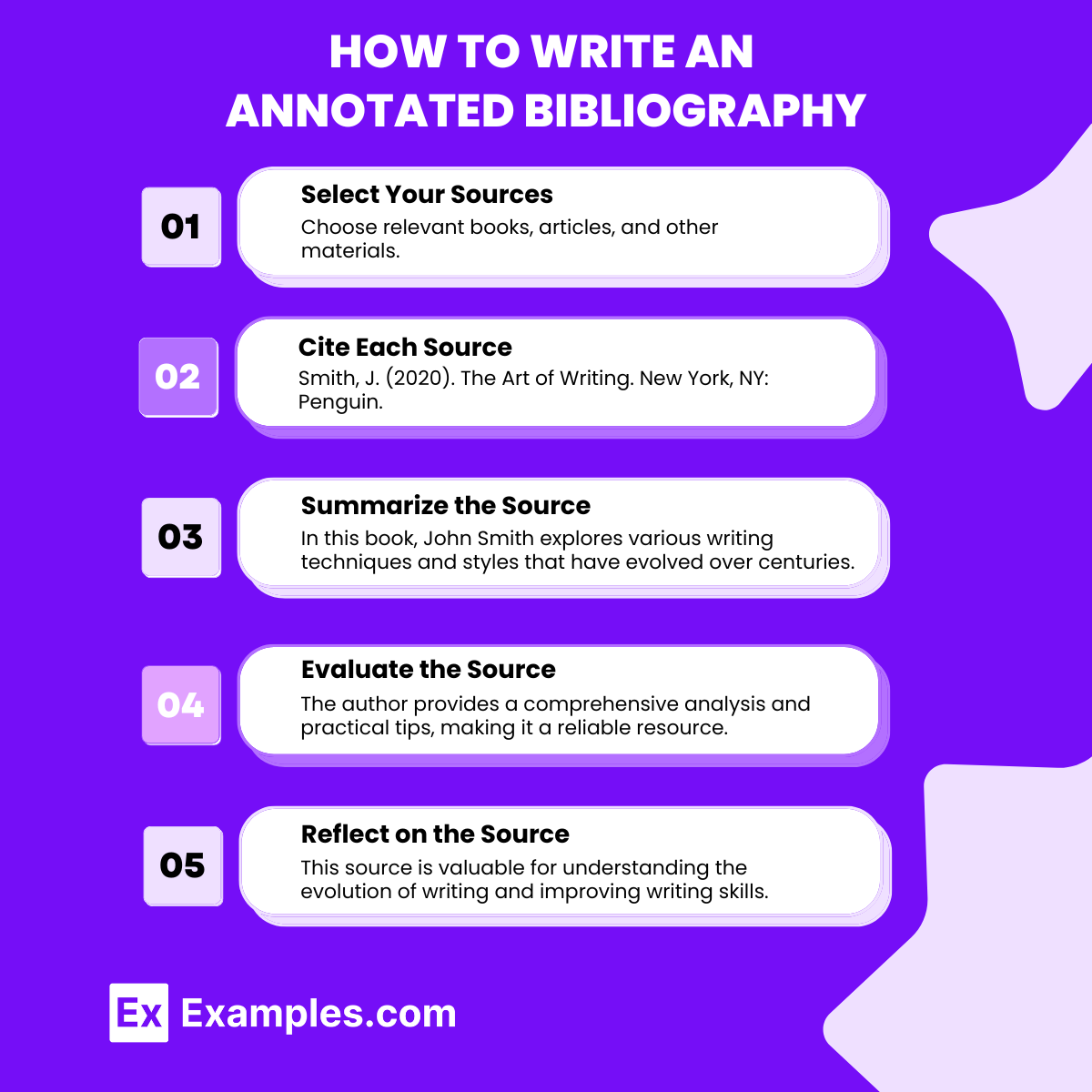
An annotated bibliography is a valuable research tool that includes citations to books, articles, and other sources, each accompanied by a brief descriptive and evaluative paragraph. This guide will walk you through the process of writing an annotated bibliography, ensuring that your work is well-organized, informative, and relevant.
Step 1: Select Your Sources
Start by choosing sources that are relevant to your research topic. These can include books, journal articles, websites, and other types of publications. Ensure that you select credible and authoritative sources to support your research.
Step 2: Cite the Sources
List your sources in alphabetical order according to the citation style required by your instructor or field of study (e.g., APA, MLA, Chicago). Each citation should include the author, title, publication date, and other pertinent information.
Example (APA Style):
Smith, J. (2020). Understanding Annotated Bibliographies. Academic Press.
Step 3: Write the Annotations
Each annotation typically consists of three parts: a summary, an evaluation, and a reflection.
- Summary: Briefly describe the main points and arguments of the source.
- Evaluation: Assess the source’s credibility, reliability, and relevance to your research.
- Reflection: Explain how this source fits into your research, how it will help you, and any insights you gained from it.
Example Annotation:
Smith, J. (2020). Understanding Annotated Bibliographies. Academic Press.
This book provides a comprehensive overview of how to compile annotated bibliographies, including the purpose, structure, and examples from various disciplines. Smith emphasizes the importance of critical thinking and offers practical tips for evaluating sources. This source is highly credible, as it is written by an expert in academic writing. It is particularly useful for my research on academic writing techniques as it provides clear guidelines and strategies that I can apply.
Step 4: Format Your Annotated Bibliography
Ensure that your annotated bibliography is formatted correctly according to the citation style you are using. Pay attention to details such as indentation, spacing, and order of entries.
Step 5: Review and Revise
Carefully review your annotated bibliography for accuracy, clarity, and completeness. Make sure each annotation is concise and informative, and that all sources are properly cited.
How do you format an annotated bibliography?
Format according to your citation style (APA, MLA, etc.), list sources alphabetically, and include a summary, evaluation, and reflection for each source.
How long should an annotation be?
An annotation is typically 100-200 words, including a summary, evaluation, and reflection on the source’s relevance to your research.
Can you include websites in an annotated bibliography?
Yes, websites can be included if they are credible and relevant to your research topic, and properly cited in your chosen citation style.
Do annotations replace the need for a bibliography?
No, an annotated bibliography includes both the citation and a descriptive/evaluative paragraph. It supplements a regular bibliography, providing more detail.
Should annotations be written in first or third person?
Annotations are usually written in third person to maintain an objective and formal tone, but check with your instructor for specific preferences.
How do I evaluate a source for an annotation?
Assess the source’s credibility, relevance, and quality. Consider the author’s expertise, the publication’s reputation, and the source’s contribution to your research.
Can I use annotations from abstracts?
No, annotations should be written by you, providing a summary, evaluation, and reflection tailored to your research needs, not just the abstract provided by the source.
Is there a specific order for elements in an annotation?
Yes, typically start with a summary of the source, followed by an evaluation of its credibility and usefulness, and conclude with a reflection on its relevance to your research.
How many sources should be in an annotated bibliography?
The number of sources depends on your assignment requirements. Typically, an annotated bibliography includes 5-20 sources, but check your guidelines.
Can annotated bibliographies include primary and secondary sources?
Yes, both primary and secondary sources can be included as long as they are relevant and credible for your research topic.




